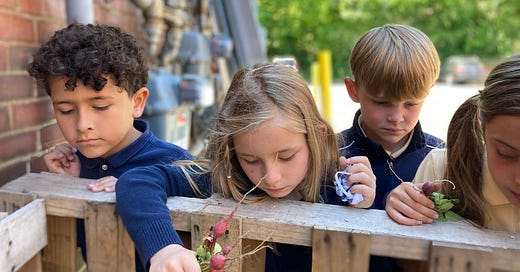Volunteers
No matter who the volunteers were or how much experience they brought with them, there was not a single family that didn’t delight me or infuse the garden with life.
Squash is a tenacious plant. The internal temperature of a hot, healthy compost pile can reach anywhere from 120 to 170 degrees Fahrenheit, cooking the seeds and roots of most plants into dutiful submission. But only a few days after my students and I spread our fresh, sifted mulch onto the new veg beds last spring, the unmistakable seed leaves of squash plants began to appear, dotting the soil where we hoped to grow tomatoes, chard, or herbs.
I hate to bring this news to the well-meaning mothers who pack their lunches, but the amount of cucumbers discarded on a daily basis by our Logic School alone is intimidating. And doubtless, these were the children of those cast-off veggies, which had survived the crucible of composting only to rear their heads in fresh surroundings.
And yet it was impossible to be sure. Anyone who has grown multiple varieties of tomatoes or, heaven help us, morning glories will understand the dilemma that faces a gardener at such moments. What was in this spot last year? Or did this seed come from the mulch? It is very difficult to be sure exactly what you will get if you let a volunteer into your space.
This mysteriousness is especially true of squash in its million forms, which all look exactly the same until the plants have grown into the size of a well-fed German Shepherd, taking up valuable real estate that could have been occupied by a known ally. I once allowed a volunteer squash to grow right out of my compost pile, excited to taste the harvest of fat Butternuts I was certain would emerge in autumn. What I got instead was a mammoth plant that yielded close to fifty decorative gourds, bright green and butter yellow, each the spitting image of the ones that had graced our Thanksgiving table the year before. The moral of the story is that volunteers will always yield something but, in order to enjoy it, you must be willing to give up the tempting illusion of control.
The same principle is true of the human volunteers who have arrived on a weekly basis this summer to help tend the Classical Roots Veg Garden: you never really know what you are going to get. Some families have been experienced and green-thumbed Rhetoric School troops who attacked the weeds in clean formation and taught me more about horticulture than I taught them. Others have been wide-eyed Grammar School families whose only growing experience was with grass and whose children could not lift a full watering can on their own.
But, no matter who the volunteers were or how much experience they brought with them, there was not a single family that didn’t delight me or infuse the garden with life. The first reason for this success is that gardening is not ultimately all that hard. The second is that the point of this particular garden is not primarily to fill people’s bodies but to feed their minds.
First and foremost, our garden is a place of education; a classroom. An unorthodox classroom in our age, but an obvious one from the perspective of history. The Benedictine monks of the Monastic Period or the strolling philosophers of the School of Athens would each recognize our garden as a place of education, of ideas exchanged, theories swapped, and passions ignited. And so it is. Many living things are thriving there—I am especially proud of our sun gold tomatoes—but chief among them are our youngest gardeners, who are asking questions and learning skills that will prove essential to the next generation of Creation’s stewards and indeed to Creation itself.
I am, therefore, in favor of letting volunteers grow. Of giving them enough space and a good mulching. Nature cannot really be controlled anyway, only shepherded. And doing so with an open mind will always yield a harvest of delight.





